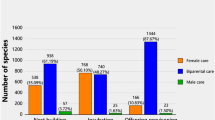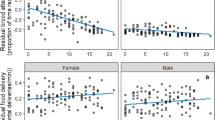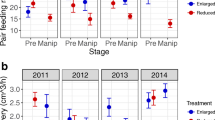Abstract
Sexual conflict is magnified during the post-fledging period of birds when the sexes face different trade-offs between continuing parental care or investing in self maintenance or other mating opportunities. Species with reversed sex roles provide a unique opportunity to study the relationship between mating systems and investment in parental care. Here, we provide the first detailed study of the length of care by males versus females (n = 24 pairs) during the post-fledging period, assessing factors that may promote care within and between the sexes. In the northern flicker Colaptes auratus, a species with partly reversed sex roles, males cared longer than females (average 16 versus 12 days, respectively). Overall, 36 % of females but no males deserted the brood prior to fledgling independence. Parents that provisioned nestlings at a high rate also spent more days feeding fledglings. Among males, age and nestling feeding rates were positively associated with the length of care. Among females, a low level of feather corticosterone (CORTf) was associated with a longer length of care. About 45 % of fledglings died within the first week, but fledglings with intermediate body mass had the highest survival suggesting stabilizing selection on mass. Fledgling survival was also higher in individuals with larger broods and lower levels of CORTf. We demonstrate that because females can be polyandrous they often desert the brood before males, and that the sexes respond to different cues relating to their energy balance when deciding the length of care given to their offspring.






Similar content being viewed by others
References
Adriaensen F, Dhondt AA, van Dongen S, Lens L, Matthysen E (1998) Stabilizing selection in blue tit fledgling mass in the presence of sparrowhawks. Proc R Soc Lond B 265:1011–1016
Angelier F, Chastel O (2009) Stress, prolactin and parental investment in birds: a review. Gen Comp Endocrinol 163:142–148
Beissinger SR, Snyder NFR (1987) Mate desertion in the snail kite. Anim Behav 35:477–487
Betts MB, Hadley AS, Rodenhouse N, Nocera JJ (2008) Social information trumps vegetation structure in breeding-site selection by a migrant songbird. Proc R Soc Lond B 275:2257–2263
Blas J, Bortolotti GR, Tella JL, Baos R, Marchant TA (2007) Stress response during development predict fitness in a wild, long lived vertebrate. Proc Natl Acad Sci USA 104:8880–8884
Bortolotti GR, Marchant TA, German T (2008) Corticosterone in feathers is a long-term, integrated measure of avian stress physiology. Funct Ecol 22:494–500
Burnham KP, Anderson DR (2002) Model selection and multi-model inference: a practical information-theoretic approach, 2nd edn. Springer, Berlin
Chapman T, Arnqvist G, Bangham J, Rowe L (2003) Sexual conflict. Trends Ecol Evol 18:41–47
Clutton-Brock TH (1984) Reproductive effort and terminal investment in iteroparous animals. Am Nat 123:212–229
Covas R, Brown CR, Anderson MD, Bomberger Brown M (2002) Stablizing selection on body mass in the sociable weaver Philetairus socius. Proc R Soc Lond B 269:1905–1909
Done T, Gow EA, Stutchbury BJM (2011) Corticosterone stress response and plasma metabolite levels during breeding and molt in a free-living migratory songbird, the wood thrush (Hylocichla mustelina). Gen Comp Endocrinol 171:176–182
Eldegard K, Sonerud GA (2009) Female offspring desertion and male-only care increase with natural and experimental increase in food abundance. Proc R Soc Lond B 276:1713–1721
Erikstad KE, Asheim M, Fauchald P, Dahlhaug L, Tveraa T (1997) Adjustment of parental effort in the puffin: the roles of adult body condition and chick size. Behav Ecol Sociobiol 40:95–100
Fairhurst GD, Marchant TA, Soos C, Machin KL, Clark RG (2013) Experimental relationships between levels of corticosterone in plasma and feathers in a free-living brid. J Exp Biol 216:4071–4081. doi:10.1242/jeb.091280
Fisher RJ, Wiebe KL (2006) Effects of sex and age on survival of northern flickers: a six-year field study. Condor 108:193–200
Goutte A, Angelier F, Welcker J, Moe B, Clement-Chastel C, Gabrielsen GW, Bech C, Chastel O (2010) Long-term survival effect of corticosterone manipulation in black-legged kittiwakes. Gen Comp Endocrinol 167:246–251. doi:10.1016/j.ygcen.2010.03.018
Gow EA, Wiebe KL (2012) An unusually synchronous double brooding attempt by a northern flicker pair. Wilson J Ornithol 124:389–392
Gow EA, Musgrove AB, Wiebe KL (2013) Brood age and size influence sex-specific parental provisioning patterns in a sex-role reversed species. J Ornithol 154:525–535
Griggio M, Matessi G, Pilastro A (2005) Should I stay or should I go? Female brood desertion and male counterstrategy in rock sparrows. Behav Ecol 16:435–441
Grüebler MU, Naef-Daenzer B (2010) Survival benefits of post-fledging care: experimental approach to a critical part of avian reproductive strategies. J Anim Ecol 79:334–341
Hõrak P (2003) When to pay the cost of reproduction? A brood size manipulation experiment in great tits (Paus major). Behav Ecol Sociobiol 54:105–112
Kokko H, Jennions MD (2008) Parental investment, sexual selection and sex ratios. J Evol Biol 21:919–948
Lima SL (1986) Predation risk and unpredictable feeding conditions: determinants of body mass in birds. Ecology 67:377–385
Lind J, Jakobsson S, Kullberg C (2010) Impaired predator evasion in the life history of brids: behavioral and physiological adaptations to reduced flight ability. In: Thompson CF (ed) Current ornithology. Springer Science, New York
Michalek KG, Winkler H (2001) Parental care and parentage in monogamous great spotted woodpeckers (Picoides major) and middle spotted woodpeckers (Picoides medius). Behaviour 138:1259–1285
Møller AP, Christe P, Erritzoe J, Mavarez J (1998) Condition, disease and immune defence. Oikos 83:301–306
Morton ES, Stutchbury BJM, Chiver I (2010) Parental conflict and brood desertion by females in blue-headed vireos. Behav Ecol Sociobiol 64:947–954
Naef-Daenzer B, Widmer F, Nuber M (2001) Differential post-fledging survival of great and coal tits in relation to their condition and fledging date. J Anim Ecol 70:730–738
Nakagawa S, Gillespie DOS, Hatchwell BJ, Burke T (2007) Predicatble males and unpredictable females: sex differences in repeatability of parental care in a wild bird population. J Evol Biol 20:1674–1681
Olson VA, Liker A, Freckleton RP, Székely T (2008) Parental conflict in birds: comparative analyses of offspring development, ecology and mating opportunities. Proc R Soc Lond B 275:301–307
Pyle P, Howell AB, DeSante DF, Yunick RP, Gustafson M (1997) Identification guide to North American birds. Slate Creek Press, New York
R Core Development Team (2012) R: a language and environment for statistical computing. Version 2.14.2. R Foundation for Statistical Computing, Vienna
Ricklefs RE, Wikelski M (2002) The physiology/life-history nexus. Trends Ecol Evol 17:462–468
Rivers JW, Liebl A, Owen JC, Martin LB, Betts MB (2012) Baseline corticosterone is positively related to juvenile survival in a migrant passerine bird. Funct Ecol 26:1127–1134
Stutchbury BJM, Gow EA, Done T, MacPherson M, Fox JW, Afanasyev V (2011) Effects of post-breeding moult and energetic condition on timing of songbird migration into the tropics. Proc R Soc Lond B 278:131–137
Styrsky JN, Brawn JD, Robinson SK (2005) Juvenile mortality increase with clutch size in a Neotropical bird. Ecology 86:3238–3244
Székely T, Cuthill IC, Kis J (1999) Brood desertion in Kentish plover: sex differences in remating opportunities. Behav Ecol 10:185–190
Székely T, Kosztolányi A, Küpper C, Thomas GH (2007) Sexual conflict over parental care: a case study of shorebirds. J Ornithol 148:S211–S217
van Noordwijk AJ, de Jong G (1986) Acquisition and allocation of resources: their influence on variation in life history tactics. Am Nat 128:137–142
White GC, Burnham KP (1999) Program MARK: survival estimation from populations of marked animals. Bird Study 46:120–138
White GC, Burnham KP, Andersen DR (2001) Advanced features of program MARK. In: Field R, Warren RJ, Okarma H, Sievert PR (eds) Wildlife, land, and people: priorities for the 21st century. The Wildlife Society, Bethesda
Wiebe KL (2005) Asymmetric costs favor female desertion in the facultatively polyandrous Northern Flicker (~Colaptes auratus~): a removal experiment. Behav Ecol Sociobiol 57:429–437
Wiebe KL (2008) Division of labour during incubation in a woodpecker Colaptes auratus with reversed sex roles and facultative polyandry. Ibis 150:115–124
Wiebe KL, Kempenaers B (2009) The social and genetic mating system in flickers linked to partially reversed sex roles. Behav Ecol 20:453–458
Wiebe KL, Moore WS (2008) Northern flicker (Colaptes auratus). In: Poole A (ed) The birds of North America online. Cornell Lab of Ornithology, Ithaca
Wiktander U, Olsson O, Nilsson SG (2000) Parental care and social mating system in the lesser spotted woodpecker Dendrocopos minor. J Avian Biol 31:447–456
Witter MS, Cuthill IC (1993) The ecological costs of avian fat storage. Philos Trans R Soc Lond B Biol Sci 340:73–92
Zuur AF, Ieno EN, Walker N, Saveliev AA, Smith GM (2010) Mixed effects models and extensions in ecology with R. Springer, New York
Acknowledgments
We thank J. Allsop, B. Griffiths, H. Hanbridge M. Mitsutani, A. Musgrove and M. Van der Pol for help in the field. T. Marchant, S. Cabezas, G. Treen and G. Fairhurst for laboratory analysis of CORTf. This research was funded by the Kenneth Molson Foundation, NSERC Discovery (K. L. W.), NSERC Canada Graduate Scholarship (E. A. G.), the Society of Canadian Ornithologists, and the Isabel Maria López Matínez Memorial Scholarship (E. A. G.). This study was conducted with Animal Care Permit number 20010113 from the University of Saskatchewan and corresponds with the current laws of Canada.
Author information
Authors and Affiliations
Corresponding author
Additional information
Communicated by Indrikis Krams.
Rights and permissions
About this article
Cite this article
Gow, E.A., Wiebe, K.L. Determinants of parental care and offspring survival during the post-fledging period: males care more in a species with partially reversed sex roles. Oecologia 175, 95–104 (2014). https://doi.org/10.1007/s00442-014-2890-1
Received:
Accepted:
Published:
Issue Date:
DOI: https://doi.org/10.1007/s00442-014-2890-1




